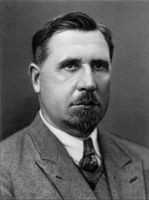Martin Latsis
| Martin Ivanovich Latsis Мартын Иванович Лацис | |
|---|---|
 | |
| Chairman of the Red Army Cheka (Eastern Front) | |
| In office July 1918 – November 1918 | |
| Chairman of the All-Ukrainian Cheka | |
| In office April 2, 1919 – August 16, 1919 | |
| Preceded by | Isaak Shvarts |
| Succeeded by | Vasiliy Mantsev |
| Chairman of Cheka in Kiev Governorate | |
| In office August 1919 – September 1919 | |
| Director of Plekhanov Institute of People's Economy | |
| In office 1932–1937 | |
| Personal details | |
| Born | December 16, 1888 Putina estate, Wenden district, Livland Governorate, Russian Empire |
| Died | March 20, 1938 (aged 49) Moscow, Russian SFSR, Soviet Union |
| Nationality | Soviet |
| Political party | Communist Party of the Soviet Union |

Martin Ivanovich Latsis (Russian: Мартын Иванович Лацис Latvian: Mārtiņš Lācis, born Jānis Sudrabs) (December 14, 1888 – February 11, 1938) was a Soviet politician, revolutionary and state security high officer from Courland (today - Latvia). He was a member of the Bolshevik Party since 1905 (an "Old Bolshevik"),[1] an active participant in the Russian Revolutions of 1905–1907 and 1917, a member of the Military Revolutionary Committee, a member of the Collegium of the All-Russia Cheka (1918–1921) and Chairman of the Cheka in Ukraine (1919), and a member of VTsIK. Between 1932 and 1937, Latsis was a director at the Plekhanov Russian Academy of Economics.
Latsis was the author of the book Dva goda borby na vnutrennom fronte ("Two Years of Struggle in the Internal Front", Moscow: Gos. izd-vo, 1920), in which he advocated unrestrained violence against class enemies. He boasted of the harsh repressive policies used by the Cheka.[2] In 1918, while a deputy chief of the Cheka in Ukraine, he established the principle that sentences were not to be determined by guilt or innocence—but by social class. He is quoted as explaining the Red Terror as follows:
We are engaged in exterminating the bourgeoisie as a class. You need not prove that this or that man acted against the interests of the Soviet power. The first thing you have to ask an arrested person is: To what class does he belong, where does he come from, what kind of education did he have, what is his occupation? These questions are to decide the fate of the accused. That is the quintessence of the Red Terror.[3]
Latsis became a victim of the Soviet regime himself during the 1930s Great Purge, when he was arrested on November 29, 1937 and accused by a commission of NKVD and Prosecutor of the USSR belonging to a "counter-revolutionary, nationalist organization". He was executed in 1938 by firing squad.[2]
In 1956, the Military Collegiate of the Supreme Court of USSR politically rehabilitated him.[2]
See also
- The black book of communism
References
- ↑ Adelman, Jonathan R. (editor); Terror and Communist Politics: The Role of the Secret Police in Communist States, Westview Press, 1984; ISBN 978-0-86531-293-7; page 81
- ↑ 2.0 2.1 2.2 "Latsis Martin Ivanovich", a biography at www.hrono.ru (in Russian)
- ↑ Tolczyk, Dariusz See no evil: Literary cover-ups and discoveries of the Soviet camp experience Yale University Press, 1999, p. 19. ISBN 978-0-300-06608-1
Literature
- Solzhenitsyn, Aleksandr; The Gulag Archipelago, Harper & Row, 660 pp., ISBN 0-06-080332-0.
- Gordievsky, Oleg; Andrew, Christopher, KGB: The Inside Story (1990), Hodder & Stoughton. ISBN 0-340-48561-2.
External links
|